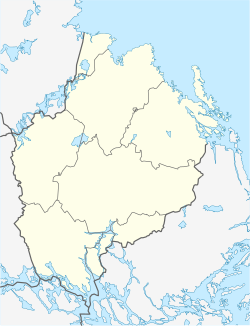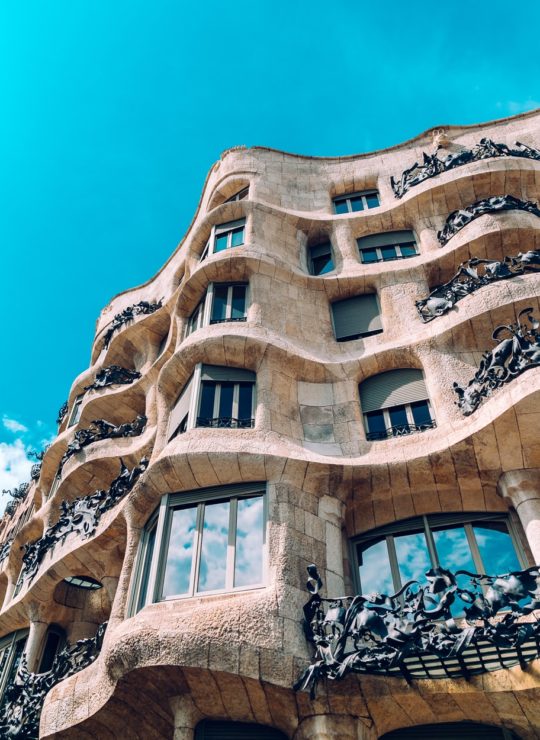| Botanical Garden of Uppsala University | |
|---|---|
| Botaniska trädgården | |
 The baroque garden of the Botanical Garden, as seen from the steps of Uppsala Castle. The building in the background is the garden's orangery. | |
| Type | Botanical garden |
| Coordinates | 59°51′9″N 17°37′45″E / 59.85250°N 17.62917°E |
| Established | 1655 (original site) 1787 (current site) |
| Founder | Olaus Rudbeck (original site) Carl Peter Thunberg (current site) |
| Designer | Olaus Rudbeck (original site) Carl Hårleman (current site) |
| Operated by | Uppsala University |
| Species | Over 7000 as of 2025 |
| Website | Official website |
The Botanical Garden of Uppsala University (Swedish: Botaniska trädgården) is the principal botanical garden in the city of Uppsala, Sweden. It is situated near to Uppsala Castle and belongs to Uppsala University, having been created on land donated to the university by King Gustav III in 1787. The orangery now houses the Linneanum museum and is open to the public alongside the University's other botanical gardens, the Linnaean Garden and Linnaeus Hammarby.
The original Botanical Garden was founded in 1655 by Olaus Rudbeck, making it the oldest botanical garden in Sweden. Having been damaged in the 1702 Uppsala fire, it fell into neglect before it was redesigned and renovated by Carl Linnaeus, a professor at the University. Under the leadership of Linnaeus, the garden's collection grew massively and it became one of the most prominent botanical gardens in the world. The original site is maintained by Uppsala University to Linnaeus' recorded design to this day.
As the original site was too wet to accommodate many species, Carl Peter Thunberg approached the King of Sweden, Gustav III, in order to move the garden to royal land in the vicinity of Uppsala Castle. Gustav III became very involved with the gardens, gifting Thunberg more land than he requested and financing the new gardens' construction. He also laid the foundation stone for the garden's orangery, and after his death the rate of construction slowed significantly, with the orangery opening in 1802.
Gustav III's successor, Gustav IV Adolf, donated a large number of living and dead animals to the garden's collection, including a live lion that was housed in the orangery. Throughout the 19th century, the garden shifted from a site of university education and research to one of public education and recreation, which was largely in line with changes in the function of botanical gardens at the time. The garden has been receiving public funds for its upkeep since the late 19th century, and is a popular location for visitors to Uppsala today.
Original site
[edit]
Botanical gardens are defined by the World Wide Fund for Nature and International Union for Conservation of Nature as "a garden containing scientifically ordered and maintained collections of plants, usually documented and labelled, and open to the public for the purposes of recreation, education and research".[1] Early botanical gardens focussed on the education of physicians and their supplies of medicine, which was similar to the function of the physic gardens in medieval monasteries. Indeed, medical training remained the primary purpose of universities' botanical gardens throughout the seventeenth and eighteenth centuries.[2]
The University of Uppsala's first botanical garden—and the first botanical garden in Sweden[3]—was situated on Svartbäcksgatan,[4] and was founded in 1655 by Olaus Rudbeck the Elder (1630–1702);[4][5] by the end of the 17th century, the collection had grown to approximately 1800 different species. In 1702, Uppsala was largely destroyed in a fire,[6][4] which caused serious damage to the garden; due to the absence of the necessary funds, the garden was not repaired for nearly forty years.[4]
It was at the Botanical Gardens—by that time completely neglected—in the spring of 1729,[7] that Carl Linnaeus (1707–1778) proved to Olof Celsius (1670–1756) his virtuosic skills in botany and earned his financial support and mentoring.[3] By May 1741, Linnaeus, who had originally been a student of Rudbeck,[4][5] had become a professor at the University, which made him responsible for both teaching its students and maintaining its botanical garden.[5] Linnaeus improved and rearranged the garden based upon his own ideas, which he documented in his 1748 work Hortus Upsaliensis (English: The Garden of Uppsala).[4] In the book, Linnaeus also claims to have invented the Celsius scale of temperature and installed it in the Botanical Garden's orangery.[8]
It was under the work of Linnaeus that the Botanical Garden would grow to 3,000 species and become one of the most prominent gardens of its time.[3] Although the main botanical garden since moved to a new site after Linnaeus' death (see § Current site), the gardens of the former site have remained under the ownership and control of Uppsala University. Now known as the "Linnaean Garden", it is maintained identically to how Linnaeus described its organisation in 1745.[4]
Current site
[edit]
After the death of Linnaeus in 1778, his student and successor Carl Peter Thunberg (1743–1828) became dissatisfied with the Linnaean Garden. Its location, near the river Fyris, meant the soil was too wet for many species of plants.[9] Thunberg approached Gustav III (1746–1792)—whose castle in Uppsala stood upon much higher ground—to request the use of the castle's formal garden as the site for the University of Uppsala's botanical gardens.[9]
The castle's large formal garden had been designed by architect Carl Hårleman (1700–1753) in the style of Baroque architecture, and was laid out in 1744.[10] Not only did Gustav III agree to gift the requested land to the University, but he also gave them another plot south of Norbyvägen to build the gardens; he also then paid the cost of landscaping the gardens for its new purpose.[9]
The official grant for the garden was signed on 17 August 1787 by Gustav III; the same day, 128 cannons were fired to celebrate the occasion and Gustav III laid the foundation stone for the garden's observatory (Swedish: Orangeriet). The orangery was built to contain a full set of Swedish coins as well as medals which depicted Gustav III, Crown Prince Gustav Adolf (later King Gustav IV Adolf; 1778–1837), and Carl Linnaeus.[11] After the death of Gustav III in 1792, funds for work on the garden and the orangery diminished which made work more difficult;[11] in spite of this, the orangrery finally opened on 25 May 1807, the centenary of Linnaeus' birth.[11]
Towards the beginning of the nineteenth century, the idea of botanical gardens being purely for medicinal purposes was no longer true; instead, they had begun to form into research centres and museums that explored the diversity of life.[2] Linnaeus himself had a menagerie—a term for a collection of exotic animals in captivity—which he stored in the Linnaean Garden, from which he displayed animals such as a tame raccoon and six monkeys, which lived in small huts on top of poles.[12] In 1802, Gustav IV Adolf gifted a large number of items to the botanical gardens that had originated from the collection of his grandmother Queen Louisa Ulrika of Sweden (1720–1782). She had been an important patron to Linnaeus during his lifetime. The same year, Gustav IV Adolf also gifted a live lion to the collection, which was housed in the orangery. It did not thrive in captivity despite even being offered—based on the scientific knowledge of the time—live chickens as food. It died from unknown causes in 1803. The University of Uppsala continued to display its zoological collections in the orangery until 1856 when it moved them to the Gustavianum, a different building belonging to the University.[11]
As the nineteenth century progressed, botanical gardens were increasingly seen as potential public spaces whose openness would offer public benefits.[2] Although the Botanical Garden remains a centre for the University of Uppsala to educate its students and allow for botanical research, its goals have expanded to also include education and recreation for the public. In return for this, the Botanical Garden has been in receipt of substantial amounts of public money since before 1897. In 1935, the garden and orangery building were designated as national monuments.[11]
In 1930, tropical greenhouses were added to the Botanical Garden, followed by a restoration program in the 1970s that returned the garden to its original design by Hårleman. As of 2011, the University of Uppsala allows public access to all three of its botanical gardens, the Botanical Garden, Linnaean Garden, and Linnaeus Hammarby. As of 2025, the modern Botanical Garden is home to over 7000 species of plants.[5] It is because of the Botanical Garden's extensive grounds, orangery, tropical greenhouses, and baroque garden that the site attracts more than 100,000 visitors every year.[11][13] Uppsala University also maintains two satellite botanical gardens: the Linnaean Garden (Swedish: Linnéträdgården), created in 1655 by Olaus Rudbeck, and the Linnaeus Hammarby (Swedish: Linnés Hammarby), the former summer home of Carl Linnaeus and his family.[14]
Gallery
[edit]- A secluded pathway with red lily pond to the left and the Linnaeum in distance
- Waterlilies in the garden's tropical greenhouse
- Baroque garden section of the gardens with Uppsala Castle in background
- Orangeriet, an 1874 drawing by C. S. Hallbeck
- A 1915 photograph of the orangery
- The baroque garden in winter, covered in snow
- One of the garden's tropical greenhouses
- Nymphaea nouchali, commonly known as Blue Lotuses, photographed at the gardens
- A flowerbed in the main section of the garden
- Hylotelephium ewersii, which are usually native to the high mountains of Asia.
- Statue of Carl Linnaeus in the Linneanum, the museum inside the orangery
References
[edit]- ^ Huxley, Anthony, ed. (1992). The New Royal Horticultural Society Dictionary of Gardening. London: Macmillan. p. 375. ISBN 978-1561590018.
- ^ a b c O'Malley, Therese (1992). "Art and Science in the Design of Botanic Gardens, 1730–1830". In Hunt, John Dixon (ed.). Garden History: Issues, Approaches, Methods. Dumbarton Oaks. pp. 279–302. ISBN 978-0884021971.
- ^ a b c Allaby, Michael (2010). Ecology: Plants, Animals, and the Environment. Infobase Publishing. pp. 76–77. ISBN 978-0-8160-6100-6.
- ^ a b c d e f g "Botanical Garden History". Uppsala University. Archived from the original on 8 June 2011. Retrieved 28 June 2011.
- ^ a b c d Osborne, Roy; Stevenson, Dennis (2025). The Cycad Botanists. Springer Nature. p. 39. ISBN 978-3031790829.
- ^ "Uppsala stad C 40 A Riksintresse för kulturmiljövården" [City of Uppsala C 40 A National Interest for Cultural Heritage Preservation] (PDF). Länsstyrelsen Meddelandeserie (in Swedish). 2014. Retrieved 1 November 2015.
- ^ Williams, Roger L. (2013). Botanophilia in Eighteenth-Century France. Laramie, Wyoming: Springer Science & Business Media. p. 19. ISBN 978-9401598491.
- ^ Allaby, Michael (2009). Atmosphere: A Scientific History of Air, Weather, and Climate. Infobase Publishing. p. 65. ISBN 978-0816060986.
- ^ a b c Stöver, Dietrich Johann Heinrich (1794). The life of Sir Charles Linnaeus. London: B and J White. pp. 157–158.
- ^ The Botanical Garden (Pamphlet). Uppsala University. p. 6.
- ^ a b c d e f Mann, Margareth (2000). "Orangeribyggnaden och Botaniska trädgården" [The Orangery and Botanical Garden] (PDF). Kulturvärden. 2000 (1). Statens fastighetsverk: 20–27. Archived from the original (PDF) on 19 March 2012. Retrieved 29 June 2011 – via archive.org.
- ^ "The Monkey Huts". University of Uppsala. Archived from the original on 8 June 2011. Retrieved 3 July 2011.
- ^ "Historia". University of Uppsala. Archived from the original on 9 July 2011. Retrieved 3 July 2011.
- ^ "University of Uppsala Botanic Garden". Botanic Gardens Conservation International. Retrieved 28 June 2011.


 Français
Français Italiano
Italiano
















